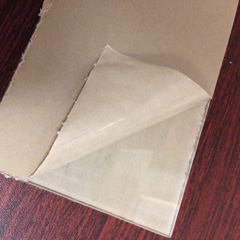| PICTURE FRAMING: ACRYLIC (PLEXIGLASS) VS. REAL GLASS
|
 |
| Here at KeenART Media Ltd., we are proud to use framing and museum grade acrylic (commonly known as plexiglass) as the transparent cover for our framing services. Not to be confused with the flimsy plastic found in dollar store frames, these days good quality acrylic is essentially indistinguishable from real glass, while also being stronger, shatter-proof and better at transmitting light. Read on to learn more about the differences between acrylic and real glass.
|
THE DIFFERENCES BETWEEN ACRYLIC AND REAL GLASS
There are a number of material differences between acrylic and real glass:
- Glass can weigh up to twice as much as acrylic.
This can be dangerous for moving large artwork, especially given the danger if it is dropped. Additionally, larger picture frames can actually bow under the weight of a glass cover. Using acrylic eliminates this risk.
| Plexi Thickness |
Weight |
| Inch |
Millimeter |
Ib |
| 1/16"(.060") |
1.5 |
0.37 / sqft |
| 1/8"(.118") |
3 |
0.70 / sqft |
- Acrylic glass can handle a stronger impact than real glass.
While glass will shatter, acrylic will usually just crack. If it does break, it tends to be into large pieces with blunted edges.
- Acrylic reflects less light than glass, meaning more will go through and illuminate your artwork.
Generally, glass allows in about 80% of light, while acrylic lets in 90-92%, thereby affording a better view of the art.
- Acrylic tends to have a clearer transparency than glass, which can give a green or orange tint to the artwork behind it.
This will give your artwork a color truer to its uncovered appearance, when viewing.
- Acrylic takes less energy than glass to process and transport.
This makes acrylic an environmentally sound choice. Acrylite, which is used at KeenART Media, is easily recycled and made from up to 75% recycled material.
- Though less breakable, acrylic can be scratched more easily than glass.
Acrylic covers should always be wiped with a soft cloth (not paper_towel). If a damp cloth is required, they must be sprayed with plastic cleaner as opposed to glass cleaner. Unlike glass, however, acrylic is usually sold with a protective paper or plastic cover, so it is perfectly clean when unwrapped, unlike glass which tends to get quite dirty in storage.
|

Acrylic weighs only half as much as glass.

Acrylic simply cracks when broken, instead of shattering dangerously.
|
ACRYLIC OR GLASS FOR FRAMING?
Transparency
The view of the artwork through the cover (sometimes called the "glazing") is an important consideration in picture framing. With the latest improvements in acrylic, arguments for glass because of its clarity and "authenticity" are now weaker. As stated above, acrylic is usually completely clear, while glass often has a tinted shade to it. However, these days there are high quality styles of glass that are relatively clear.
Protecting the Art
Another point to consider is the long term effects of the artwork's environment on the art itself. Since light rays can eventually damage or dull a painting or print, UV protection is necessary for important or expensive pieces of art. Today, both acrylic and glass have UV-resistant options. "Museum-Grade" acrylic sheets can block up to 98% of UV rays, but the same property is now applied to certain types of museum glass. Unfortunately, there doesn't seem to be a 100% option, so keeping your art out of direct sunlight is always the best idea.
Another aspect of the environment that is often overlooked is the effect of the glazing on the artwork itself. The shatter-free nature of acrylic not only keeps kids and pets safe; this quality also protects your artwork. If the piece should fall, the frame may still break, and the acrylic might crack, but no shattered pieces of glass will puncture and ruin your art.
However, acrylic tends to produce more static than glass, and if the medium you are framing is loose - like graphite or pastels - there have been reports of the medium being drawn off the paper, should the acrylic and artwork touch.
Using a mat to divide the art from the acrylic is generally enough to protect it. There are also anti-static sprays and brushes designed especially for this purpose. Alternately, you may choose to use glass for these types of art.
|

Regular acrylic is very clear, with some visible reflection.

Non-glare acrylic looks similar, but with no reflection.
|
THE ACRYLIC GLASS WE USE
Our quality, wood picture frame mouldings are paired with Acrylite® Framing & Museum Quality "acrylic sheet". We offer three choices, depending on what qualities you seek:
- Framing grade (FF3): this high quality acrylic is guaranteed to be free of defects. It is suitable for a wide variety of framing projects, from shadow boxes, photography or fine art prints.
- Non-Glare (P99): This two-sided acrylic features a pebbled surface that greatly reduces glare, giving your art a "glass-less" appearance. The side that lies against the artwork is not textured - this keep the acrylic from fogging or blurring the image.
- UV Filtering Non-Glare (OP3 P99): Similar to the non-glare acrylic, this sheet features UV protection that makes it an archival-quality material. It protects against both natural and artificial light.
|

The acrylic sheet is wrapped until it is put into the frame.
|
|
Whatever you're framing, be it an original artwork, a fine art print or a 3-dimensional object, the clear cover you place over deserves consideration. KeenART Media's excellent acrylic sheet glazing is a great cover worth trying. Options and quality combine to result in the perfect framing experience!
If you have any questions about any of our framing products, do not hesitate to contact us. Our knowledgeable staff is always happy to assist.
|
|
To order custom cut Plexi Glass: click here
|


|

|
Custom-Made Picture Framing, Custom Stretcher Bar Frames
, Custom Artist Canvas, Custom Canvas Stretching, Canvas transfer & Dry Mounting Services
A division of USA On Canvas -
|
|
© 2002-2025 - KeenART Media Ltd.
|
|
| |
|

